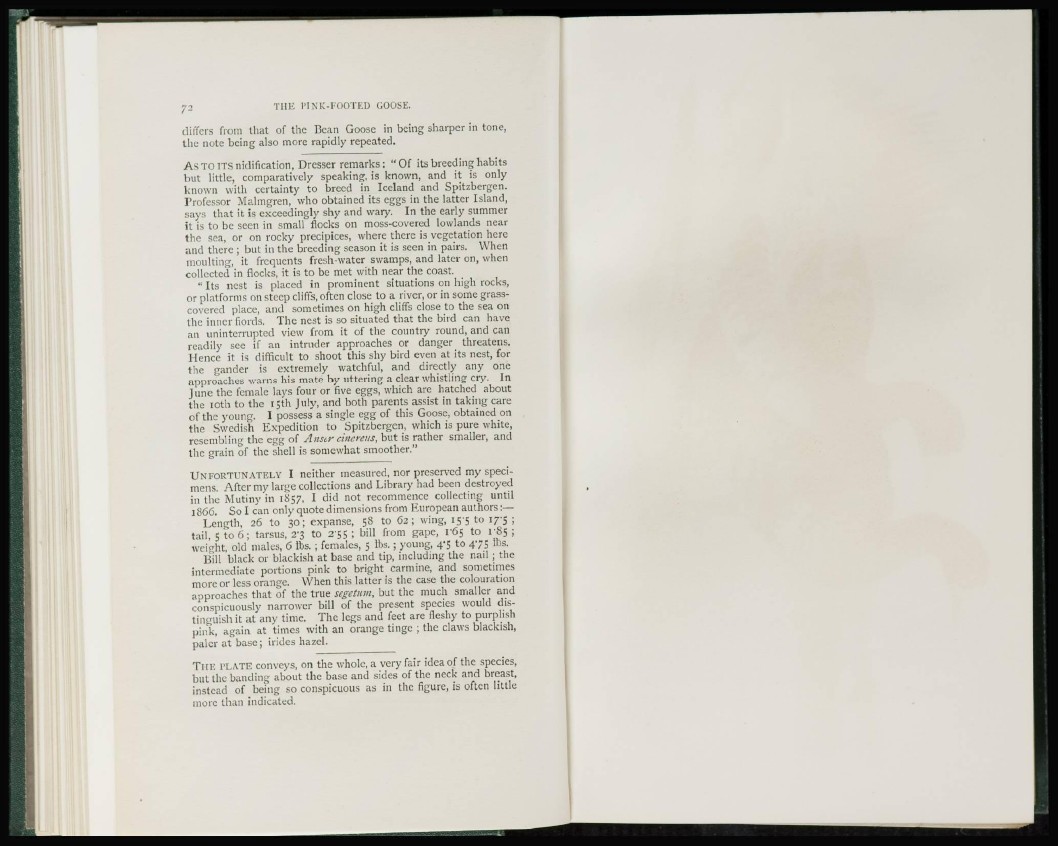
differs from lhat of the Bean Goose in being sharper in tone,
the note being also more rapidly repeated.
As TO ITS nidification, Dresser remarks: "Of its breeding habits
but little, comparatively speaking, is known, and it is only
known with certainty to breed in Iceland and Spitzbergen.
Professor Malmgren, who obtained its eggs in the latter Island,
says that it is exceedingly shy and wary. In the early summer
it is to be seen in small flocks on moss-covered lowlands near
the sea, or on rocky precipices, where there is vegetation here
and there ; but in the breeding season it is seen in pairs. When
moulting, it frequents fresh-water swamps, and later on, when
collected in flocks, it is to be met with near the coast.
" Its nest is placed in prominent situations on high rocks,
or platforms on steep cliffs, often close to a river, or in some grasscovered
place, and sometimes on high cliffs close to the sea on
the inner fiords. The nest is so situated that the bird can have
an uninterrupted view from it of the country round, and can
readily see if an intruder approaches or danger threatens.
Hence it is difficult to shoot this shy bird even at its nest, for
the gander is extremely watchful, and directly any one
approaches warns his mate by uttering a clear whistling cry. In
June the female lays four or five eggs, which are hatched about
the ioth to the 15th July, and both parents assist in taking care
of the young. 1 possess a single egg of this Goose, obtained on
the Swedish Expedition to Spitzbergen, which is pure white,
resembling the egg of Anstr cinereus, but is rather smaller, and
the grain of the shell is somewhat smoother."
UNFORTUNATELY I neither measured, nor preserved my specimens.
After my large collections and Library had been destroyed
in the Mutiny in 1857, I did not recommence collecting until
1866. So I can only quote dimensions from European authors:—
Length, 26 to 30; expanse, 58 to 62; wing, 155 to 17-5 ;
tail, 5 to 6 ; tarsus, 2'3 to 255 ; bill from gape, 1/65 to 185 ;
weight, old males, 6 lbs. ; females, 5 lbs.; young, 4-5 to 475 lbs.
Bill black or blackish at base and tip, including the nail ; the
intermediate portions pink to bright carmine, and sometimes
more or less orange. When this latter is the case the colouration
approaches that of the true segetum, but the much smaller and
conspicuously narrower bill of the present species would distinguish
it at any time. The legs and feet are fleshy to purplish
pink, again at times with an orange tinge ; the claws blackish,
paler at base; irides hazel.
THE PLATE conveys, on the whole, a very fair idea of the species,
but the banding about the base and sides of the neck and breast,
instead of being so conspicuous as in the figure, is often little
more than indicated.